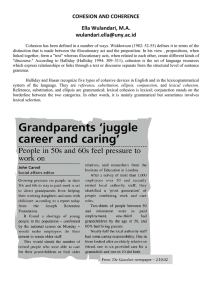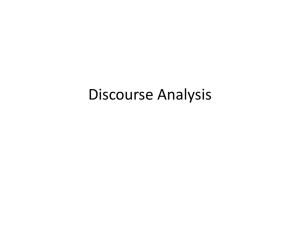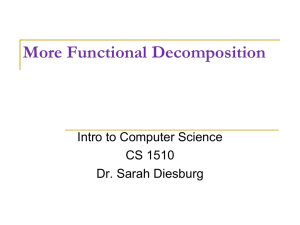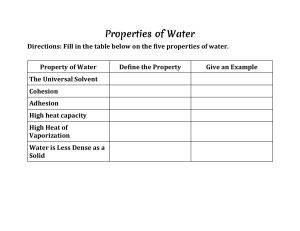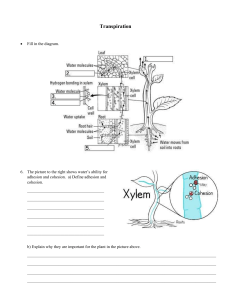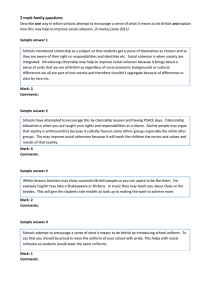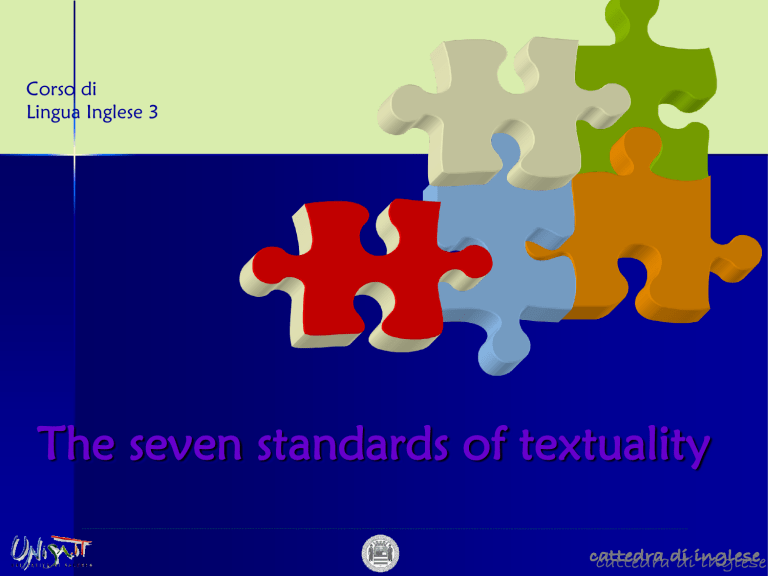
Corso di Lingua Inglese 3 The seven standards of textuality What distinguish texts is the quality of textuality Textuality is the result of seven factors and depends on both the writer and the reader to varying degrees: COHESION and COHERENCE are text-centred notions, designating operations directed at the text materials. Cohesion concerns the ways in which the components of the surface text (the actual words we hear or see) are mutually connected within a sequence (de Beaugrande & Dressler 1981:3). Coherence on the other hand concerns the ways in which the components of the textual world, i.e. the concepts and relations which underlie the surface text are mutually accessible and relevant. The remaining standards of textuality are user-centred, concerning the activity of textual communication by the producers and receivers of texts: Intentionality concerns the text producer’s attitude that the set Acceptability concerns the receiver’s attitude that the set of Informativity concerns the extent to which the occurrences of Situationality concerns the factors which make a text relevant Intertextuality concerns the factors which make the utilisation of occurrences should constitute a cohesive and coherent text instrumental in fulfilling the producer’s intentions. occurrences should constitute a cohesive and coherent text having some use or relevance for the receiver. the text are expected vs. unexpected or known vs. unknown/uncertain. to a situation of occurrence. of one text dependent upon knowledge of one or more previously encountered texts. COHESION The ties that bind a text together. Halliday and Hasan define two general categories of cohesion: grammatical cohesion (substitution, lexical cohesion (reitreration and ellipsis, conjunction, reference) collocation. Grammatical cohesion REFERENCE “The semantic relation that ensures the continuity of meaning in a text.” It includes items that cannot be interpreted in their own right, but which make reference to something else for their interpretation. Ex: Doctor Foster went to Gloucester in a shower of rain. He stepped in a puddle right up to his middle and never went there again •Exophoric reference: Reference to items outside the text •Endophoric reference: Reference to items within the text •Cataphoric Forward pointing (This is not good news for any of you. You are all fired.) •Anaphoric Backward pointing (John came in. He did x, he did ) Grammatical cohesion SUBSTITUTION A grammatical relation, where one linguistic item substitutes for a longer one. The substitute item is therefore interpretable only by reference to the original longer item. – Nominal s. (one, ones, the same – Verbal s. (do) It might rain but I hope it doesn’t – Clausal s. (they say so) Grammatical cohesion ELLIPSIS It is similar to substitution, except that in the case of the ellipsis the substitution is by nothing. – Nominal s. (omission of the head of a noun phrase) – Verbal s. (omission of the lexical verb) – Clausal s. (ellipsis of large part of clauses) I voted for the Greens. Why? Grammatical cohesion CONJUNCTIONS Specific devices for linking one sentence to another: – – – – Additive Adversative Causal Temporal James arrived and sat down. I’m hungry but don’t want to eat now. Lexical cohesion Lexical cohesion does not deal with grammatical or semantic connections but with connections based on the words used. It is achieved by selection of vocabulary, using semantically close items. Because lexical cohesion in itself carries no indication whether it is functioning cohesively or not, it always requires reference to the text, to some other lexical item to be interpreted correctly. There are two types of lexical cohesion: – reiteration – collocation. Lexical cohesion REITERATION Reiteration includes: repetition (often involving reference) A conference will be held on national environmental policy. At this conference the issue of salination will play an important role. synonymy (often involving reference) A conference will be held on national environmental policy. This environmental symposium will be primarily a conference dealing with water. hyponymy (superordinate vs. subordinate concepts) We were in town today shopping for furniture. We saw a lovely table. metonymy (part vs. whole) At its six-month check-up, the brakes had to be repaired. In general, however, the car was in good condition. antonymy The old movies just don’t do it anymore. The new ones are more appealing. Lahdenmäki (1989) calls these relations "(direct) synonym-type relations, since they all refer to another word which has the same referent (e.g. I met a man yesterday. The bastard stole all my money)". Lexical cohesion COLLOCATION Collocation is any pair of lexical items that stand to each other in some recognisable lexico-semantic relation, e.g. "sheep" and "wool", "congress" and "politician", and "college" and "study". Red Cross helicopters were in the air continuously. The blood bank will soon be desperately in need of donors. The hedgehog scurried across the road. Its speed surprised me. Like in the case of synonymous reference, collocational relation exists without any explicit reference to another item, but now the nature of relation is different: it is indirect, more difficult to define and based on associations in the reader’s mind (e.g. I looked into the room. The ceiling was very high). Interpretation of such relations is completely based on the knowledge of subject fields). Collocations words which tend to occur with other words. ‘language’: first language, second language, foreign language, dead language, classical language, modern language, spoken language, written language, colloquial language, sign language, body language, legal or technical or scientific language; speak a language, understand a language, learn a language, study a language etc. are all examples of collocations. A famous quotation on collocations by the linguist Firth: You shall know a word for the company it keeps. Paragraphs are often highly cohesive entities. The cohesive ties can stand out very clearly if he sentences are shuffled into a random order. It may even be possible to reconstitute the original sequence solely by considering the nature of these ties, as in the following case: 1. However, nobody had seen one for months. 2. He thought he saw a shape in the bushes. 3. Mary had told him about the foxes. 4. John looked out of the window. 5. Could it be a fox? Solution: 1. 2. 3. 4. 5. John looked out of the window He thought he saw a shape in the bushes Could it be a fox? Mary had told him about the foxes. However, nobody had seen one for months This is the closing paragraph of Joyce’s short story A Painful Case. The sequence of pronouns, the anaphoric definite articles and the repeated phrases are the main cohesive features between the clauses and sentences. Several refer back to previous parts of the story, thus making this paragraph, out of context, impossible to understand. He turned back the way he had come, the rhythm of the engine pounding in his ears. He began to doubt the reality of what memory told him. He halted under a tree and allowed the rhythm to die away. He could not feel her near him in the darkness nor her voice touch his ear. He waited for some minutes listening. He could hear nothing: the night was perfectly silent. He listened again: perfectly silent. He felt that he was alone. He turned back the way he had come, the rhythm of the engine pounding in his ears. He began to doubt the reality of what memory told him. He halted under a tree and allowed the rhythm to die away. He could not feel her near him in the DARKNESS nor her voice touch his ear. He waited for some minutes listening. He could hear nothing: the NIGHT was perfectly silent. He listened again: perfectly silent. He felt that he was alone. Find out all the cohesive devices: The first sign of the new man was the knock of the door, It was the landlady, knocking at Ann’s door, as she’d thought, but on the other door, the one east of the bathroom. Knock, knock, kock; then a pause, soft fotsteps, the sound of unlocking. Ann, who had been reading a book on canals, put it down and lit herself a cigarette. It wasn’t that she tried to overhear: in this house you couldn’t help it. Ambiguity in texts can derive from the workings of cohesion or the lack of cohesion COHERENCE The concepts and relationships expressed should be relevant to each other, thus enabling us to make plausible inferences about the underlying meaning. In Text and Context, Teun A. van Dijk (p. 93) argues convincingly that coherence is a semantic property of discourse formed through the interpretation of each individual sentence relative to the interpretation of other sentences, with "interpretation" implying interaction between the text and the reader. One method for evaluating a text's coherence is topical structure analysis. Coherence, the sub-surface feature of a text, concerns the ways in which the meanings within a text (concepts, relations among them and their relations to the external world) are established and developed. Some of the major relations of coherence are logical sequences, such as cause-consequence (and so), conditionconsequence (if), instrument-achievement (by), contrast (however), compatibility (and), etc. Moreover, it is the general ´aboutness´, i.e., the topic development which provides a text with necessary integrity; even in the absence of overt links, a text may be perceived as coherent (i.e., as making sense), as in various lists, charts, timetables, menus. Contrarily, other types of texts are characterized by explicit cohesive structure signalling intricate logico-semantic relationships (scientific reports, legal texts); in literary works, cohesion may be programmatically suppressed in order to enhance readers´ enjoyment while discovering these links for themselves. Read the following and discuss them in terms of cohesion and coherence: A: Have you seen Tom? B: The black car is not here; My father once bought a Lincoln. He did it by saving every penny he could. That car would be worth a fortune today. However, he sold it to help pay for my college education. Sometimes, I think I’d rather have the Lincoln; My father bought a Lincoln. The car driven by the police was red. That color doesn’t suit her. She wrote three letters. However, a letter isn’t as fast as an e-mail message and my mailing box is full of spam. The fear of the enemy upset our plans.

